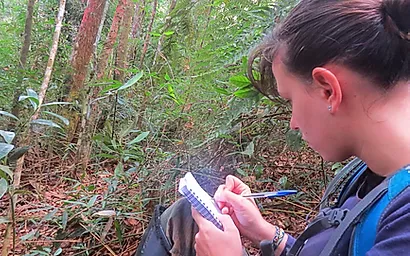What do titi monkeys’ calls mean?
Time
Monday, 13. July 2020
11:45 - 12:45
Location
Online
Organizer
Centre for the Advanced Study of Collective Behaviour
Speaker:
Mélissa Berthet, École Normale Supérieure
This event is part of an event series „Seminar Series of CASCB“.
View the recording of Mélissa's talk here
Mélissa Berthet is a Postdoc at the École Normale Supérieure in France. She studies animal communication to understand what makes human language unique and how it evolved. She uses a linguistic approach to study the semantics of animal communication, which allows the drawing of accurate predictions about meaning of general alarm calls. She also studies linguistic capacities of captive species by conducting experiments and collaborates with linguists and biologists to develop the emergent field of animal linguistics and train researchers interested in this approach.
What do titi monkeys’ calls mean?
Titi monkeys combine A-calls and B-calls into long sequences in alarm situations. Several studies investigated the linguistic properties of the titi monkeys alarm system but their conclusions remain debated. Here, I try to address this issue by exploring the semantic, syntactic and pragmatic capacities of titi monkeys in alarm situations, using methodologies borrowed from biology and linguistics. I argue that the A- and B-calls reflect the emotional state of the caller, and that sequences do not exhibit syntactic structures but are readouts of the internal state of the caller. On the other hand, it seems that listeners rely on pragmatics to infer reliable, probabilistic information about predator type and location from conspecifics’ alarm sequences. Overall, this work shows that combining methodologies from biology and linguistics can bring new and unexpected insights into our understanding of nonhuman communication, and ultimately help us retracing how human language evolved.

